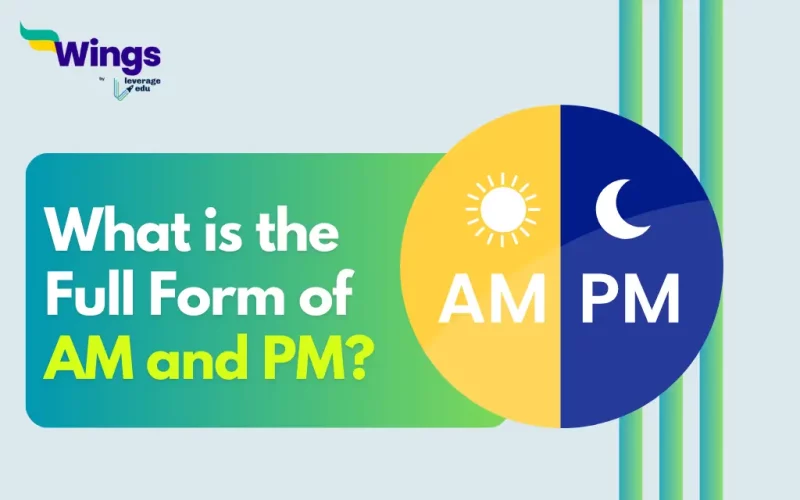The Full Form of AM is Ante Meridiem and PM is Post Meridiem. AM and PM are both Latin terms used in the 12-hour clock format. Furthermore, AM refers to the time between midnight and noon, on the other hand, PM refers to the time between noon and midnight. Let us get into the details of the Full Form of AM and PM right here!
What is the Full Form of AM?
Table of Contents [show]
The full form of AM is Ante-Meridiem. The 12 hours on a calendar that come Before Noon is referred to as “AM” in Latin. The term Ante Meridiem means before noon. Additionally, it is a unit of the time standard and corresponds to the 12-hour clock. Moreover, the 12-hour clock separates a day’s time cycle into two parts. Ante Meridiem, or AM, is the name of the initial stage. Thus, Ante Meridiem or AM refers to the time between midnight and noon.
Fascinating Fact! AM and PM are part of the 12-hour clock system, which competes with the 24-hour clock (military time) around the world. The 24-hour clock avoids confusion by simply using all 24 hours without needing AM or PM!
What is the Full Form of PM?
The full form of PM is Post Meridiem. PM stands for post-midday. It is yet another conventional time unit connected to the 12-hour clock. In addition, the period is divided into two equal periods, the first period and the second period, according to the 12-hour clock system. Moreover, the second period is known as PM, or Post Meridiem. The time displayed in Post Meridiem is from Noon to Midnight.
Also Read: What is the Full Form of WMO?
Uses of AM and PM
There are two different types of clocks: ones that run for 12 hours and the other for 24 hours. Since a day consists of 24 hours, it is simple to tell the time in the format of 24 hours without using any units. However, each number is repeated twice daily in a pattern of 12 hours.
Although it is not much of a problem when you read the time because you can easily distinguish whether it is day or night. Nonetheless, if you need to record the time of an event for future use, you must specify whether it is 1 o’clock in the morning or 1 o’clock in the afternoon. The a.m. and p.m. units are applied here. Hence, 1 AM or 1 PM.
Also Read: What is the Full Form of DSP?
Fun Fact About AM and PM
It might be interesting to know that the idea of a 12-hour clock is not new. Egyptians and Mesopotamians utilised it in simple forms even in earlier times. Examples include the Egyptian water clock for use at night and the Egyptian sun-dial clock for use during the day, both of which were discovered in a pharaoh’s tomb.
Difference between Clock Systems
Furthermore, the differences between the 12-hour and 24-hour clock systems are as follows:
| Difference between Clock Systems | |
| 24-Hour Clock System | 24 Hour Clock System |
| 12:00 AM | 00:00 |
| 1:00 AM | 01:00 |
| 2:00 AM | 02:00 |
| 3:00 AM | 03:00 |
| 4:00 AM | 04:00 |
| 5:00 AM | 05:00 |
| 6:00 AM | 06:00 |
| 7:00 AM | 07:00 |
| 8:00 AM | 08:00 |
| 9:00 AM | 09:00 |
| 10:00 AM | 10:00 |
| 11:00 AM | 11:00 |
| 12:00 PM | 12:00 |
| 1:00 PM | 13:00 |
| 2:00 PM | 14:00 |
| 3:00 PM | 15:00 |
| 4:00 PM | 16:00 |
| 5:00 PM | 17:00 |
| 6:00 PM | 18:00 |
| 7:00 PM | 19:00 |
| 8:00 PM | 20:00 |
| 9:00 PM | 21:00 |
| 10:00 PM | 22:00 |
| 11:00 PM | 23:00 |
Popular Full Forms
We hope this blog has helped you understand the Full Form of AM and PM and everything related to it. If you want to know more, find the 300+ full forms list on our blog. Moreover, in the world of short forms, you can rely on the Leverage edu page to know about more full forms like this! Connect with us study abroad experts to achieve your international dream today!
 One app for all your study abroad needs
One app for all your study abroad needs















 45,000+ students trusted us with their dreams. Take the first step today!
45,000+ students trusted us with their dreams. Take the first step today!
